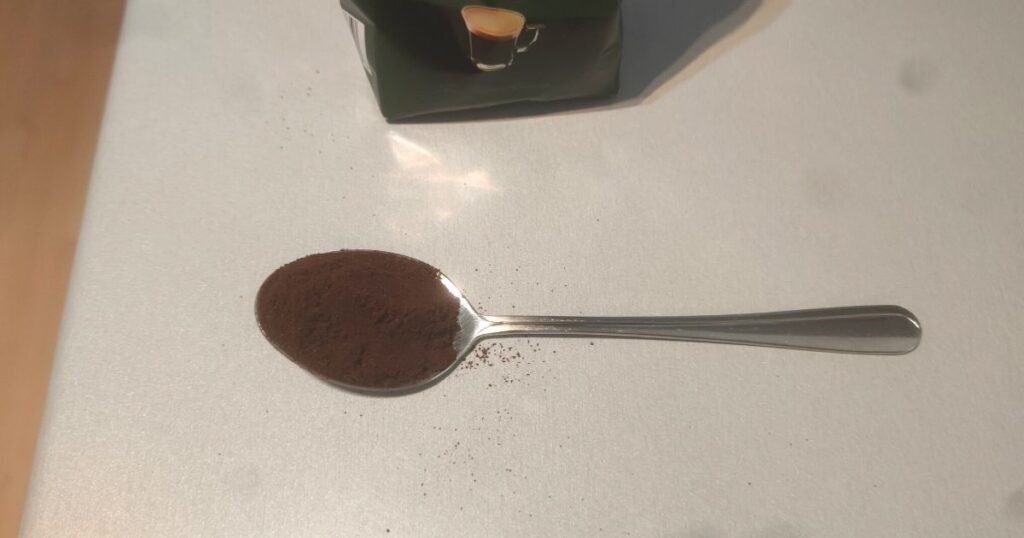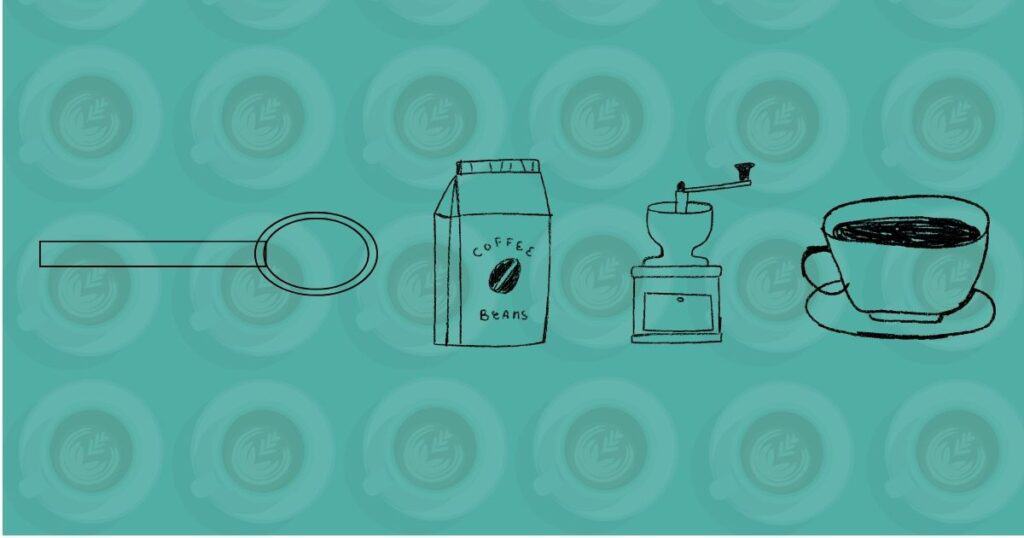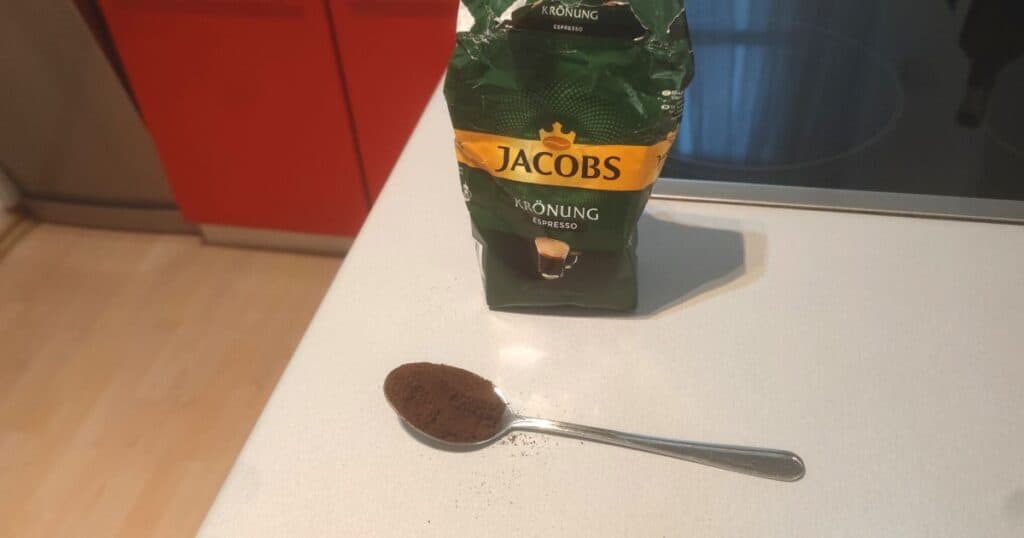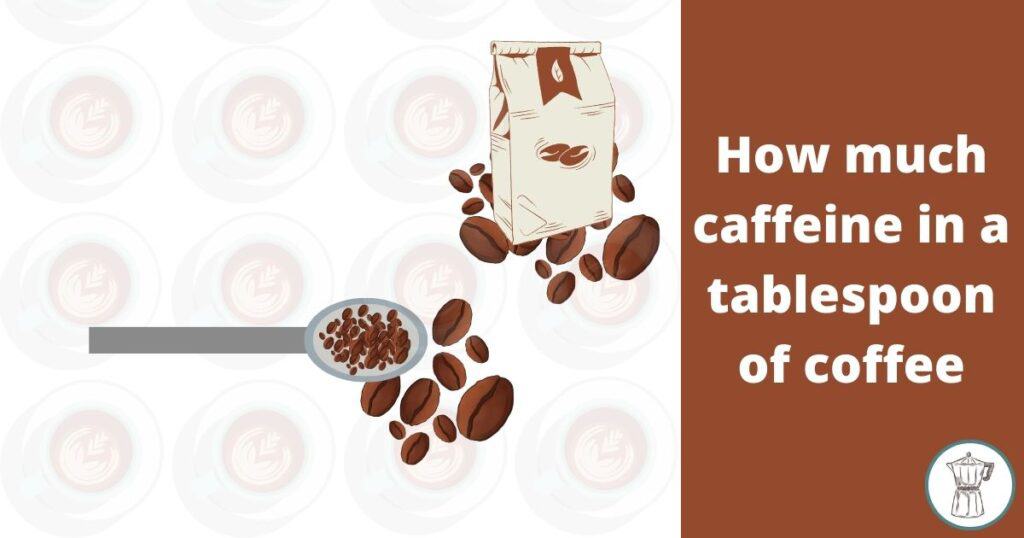How much caffeine is in a tablespoon of ground coffee? It’s no secret that coffee contains caffeine and… is the pope Catholic? Coffee is the real deal, the only beverage that does the trick for many to kick-start their day. The aroma and taste are also facets of coffee that make it so addictive. But as you probably know it’s no good having too many cups a day because of its caffeine content. But how much caffeine is in a tablespoon of ground coffee? Let’s chat about coffee, caffeine and a few tips on how to drink it in moderation.
Key takeaways:
- The amount of caffeine in a tablespoon of ground coffee
- The main differences between Robusta and Arabica coffee
- The caffeine content of four different coffee types in an 8-oz cup
- The exact amount of caffeine you’ll find in just one single coffee bean
How much caffeine is actually in a tablespoon of ground coffee?
Depending on the roasting process, the amount of caffeine in a tablespoon of ground coffee is as follows, for example, Arabica coffee contains about 60mg while Robusta about 110mg. The most common coffee roasts are:
- Light
- Medium
- Medium-Dark
- Dark

Caffeine depending on the coffee origin
Here are some top brands I personally tried and the caffeine in each every one of them:
- Brazil Santa Barbara Yellow Bourbon 2.8%
- Ethiopian Harrar Moka 1.13%
- Indian Mysore 1.37%
- Guatemalan Antigua 1.32%
- Mexico Pluma Altura 1.17%
- Yemen Mocha Mattari 1.01%
Why your coffee is likely to have a higher concentration of caffeine per tablespoon than Arabica
It’s worth taking a look at these different cases when a tablespoon of coffee contains more caffeine than say, Arabica, which is regarded as having the average caffeine blast.
- Coffee beans coated with chocolate; the amount of caffeine in one tablespoon of chocolate-covered coffee is about more than three times that of Arabica coffee.
- Instant coffee which according to the USDA, a teaspoon (1.8g) of instant coffee has approximately 57 mg of caffeine in it. Fortunately, you need very little for each cup of coffee.
- Compared to 5g of ground coffee per level tablespoon, which has roughly three times as much caffeine as a standard tablespoon of instant coffee.
- The amount of caffeine in blends of Arabica and Robusta will be much higher per tablespoon than pure Arabica coffee, especially in blends with higher Robusta content.
Interestingly, the amount 65%-90% of ground coffee is released when it’s brewed.
What are the main differences between Robusta and Arabica coffee?
- In general pure Robusta roast is higher in caffeine than pure Arabica coffee beans – you’ll find almost double the amount of caffeine in Robusta.(But it all depends on the brand; many coffees are blended and aren’t 100% pure so there are Robusta coffees that aren’t as strong as others and the same goes for the Arabica roasts.)
- Arabica often has a smoother taste with hints of sweetness and chocolate. They also frequently include undertones of berries or fruits. On the contrary, Robusta has a sharper, harsher, and more bitter flavour with undertones of grains or wheat.
- Robusta is generally preferred to Arabica for making espresso as it makes a better crema.
How much is in a cup of coffee?
It depends a lot on the coffee type and for that reason let’s go over some of the most popular:
1. Dripping coffee
Brewed coffee is the one I have in the morning and what I’ll have at work to keep me going on a hectic day. A cup of brewed coffee roughly contains 70-140 mg.

2. Espresso
I love espresso; it really gives me a kick. A shot of a espresso cup is 30 to 50 ml and contains 63 mg of caffeine
3. Decaf coffee
Its name of decaf coffee is 100% misleading as there’s caffeine, but as you might have guessed is very little (about 5-10mg in a cup but it also depends on the brand).
4. Instant coffee
As we already mentioned above it’s stronger than brewed coffee but paradoxically a cup of instant coffee has less caffeine than a brewed coffee (only about 35 to 90 mg).
Here’s a table that summarises the different kinds of coffee and the caffeine content of each one:
| Type of coffee | Caffeine |
| Dripping coffee | 70-140 mg (per 8-oz cup) |
| Espresso | 63mg (per espresso shot) |
| Decaf coffee | 5-10 mg (per 8-oz cup) |
| Instant coffee | 35-90 mg (per 8-oz cup) |
Caffeine in regular coffee vs. instant
Here’s an interesting fact. How come a cup of instant coffee has less caffeine than regular coffee since it’s higher in caffeine per gram? It’s because we use much less instant coffee to make a cup than say when making filter coffee.
Instant coffee contains around 32mg per gram caffeine whilst filter coffee is around 10-12. But again we usually use at least 4 times more coffee to make a regular brew.
A 6 oz cup of instant coffee would contain roughly 57 milligrams of caffeine, assuming a 100 percent caffeine extraction, which seems impossible to happen. This is far less than the 70–135 mg of caffeine in a filter cup of coffee.

How To apply the theory about the caffeine in a tablespoon of coffee
Okay, so we saw all the numbers about coffee and caffeine. Let’s put them in perspective.
Let’s say that you’re going use Arabica coffee beans for your brew, they have 60mg of caffeine, but as mentioned 70%-90% of the caffeine ends up in your cup (42-54mg). Keeping in mind that the FDA recommends only 400mg caffeine a day it means that your threshold should be about 7 tablespoons of coffee per day or fewer cups and a slice of cake with espresso powder.
Coffee lover states this about caffeine content:
I think it is not so much about caffeine itself but the source. Most commonly, coffee is the main source of caffeine we all turn too and yes it is good in providing caffeine we need to boost our energy levels and focus. But unlike coffee, tea leaves and tea in general contains Theanine. A substance which refreshes us, provides relief of stress, anxiety and at the same time helps us to stay sharp.
– Maria Sheck
How much caffeine will you find in a coffee bean?
Depending on the type of coffee, one coffee bean is believed to contain up to 6 milligrams of caffeine. In comparison to Robusta coffee, which has 22 mg of caffeine per gram, Arabica coffee has 12 mg of caffeine per gram.
Let’s wrap it up
Next time you make coffee remember, this is the amount of coffee per bean, this is the amount of coffee per spoon, and these are the spoons you can have per day. You now have control over your caffeine intake. If you already have your 7 tablespoons of coffee and reached your 400mg of caffeine, but a friend invites us around for coffee go for water instead. It’s a good idea to brew coffee right after you’re done with the grinding – drinking expired coffee isn’t a good idea.
FAQs about caffeine content in a tablespoon of coffee grinds
Let’s go over two common questions that often come up regarding caffeine content in ground coffee.
How many tablespoons of coffee is it ideal to use per cup?
1 gram of coffee grounds typically uses 15–18 grams/millilitres of water. You use between 212 and 3 tablespoons (13–15 grams) of ground coffee for an 8 oz (237 ml) cup of coffee. A weaker brew results from using fewer tablespoons of coffee and vice versa.
Is it too much to have coffee with two tablespoons of coffee?
6-7 ounces of coffee can be brewed with just two tablespoons of coffee. When boiling a larger mug of coffee, you might wish to add more grounds since a single spoon only carries roughly 5 grams of ground coffee.
This is what coffee expert says about daily caffeine consumption:
While it might not have as adverse affects as alcohol or tobacco, caffeine is a drug and it’s very concerning to see how many people “need a cup of coffee” just to function.
Imagine if someone said “don’t talk to me until I’ve had a shot of vodka” like they’d be going straight to rehab.
– r/unpopularopinion

- How to Remove Coffee Stains From Countertop The Easy Way - December 21, 2023
- Can You Reuse Coffee Grounds in French Press? Truth Inside - December 12, 2023
- Can Expired Coffee Creamer Make You Sick? 3 Ways to Find Out - December 9, 2023
